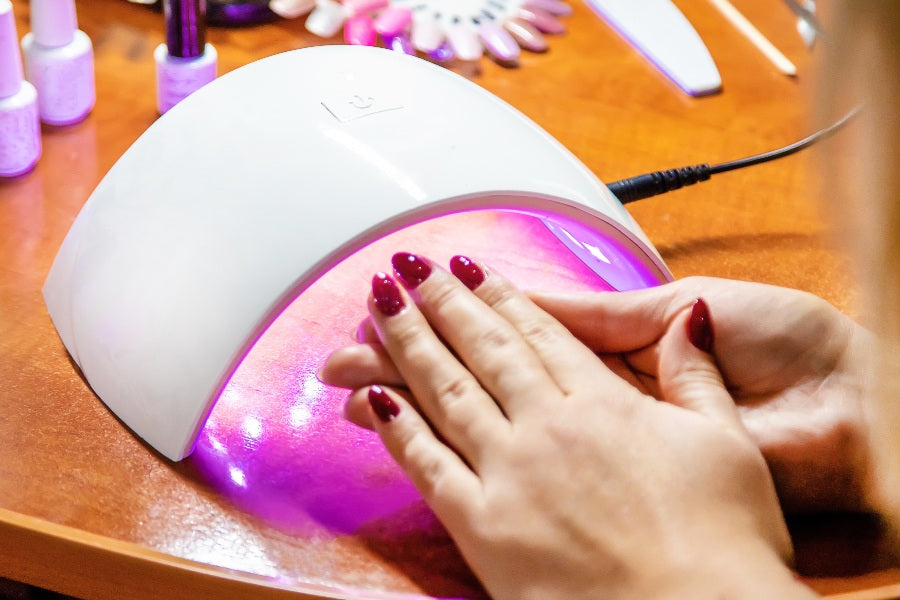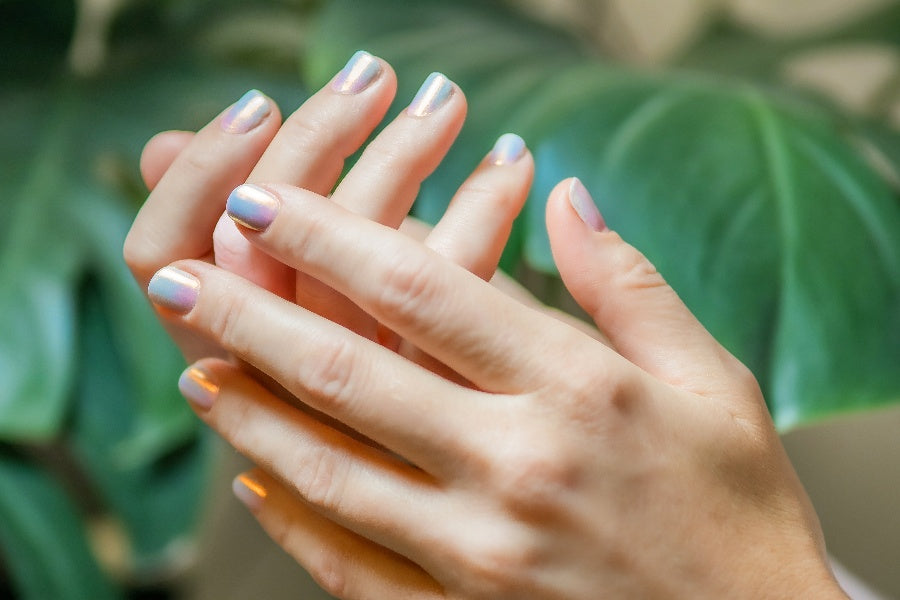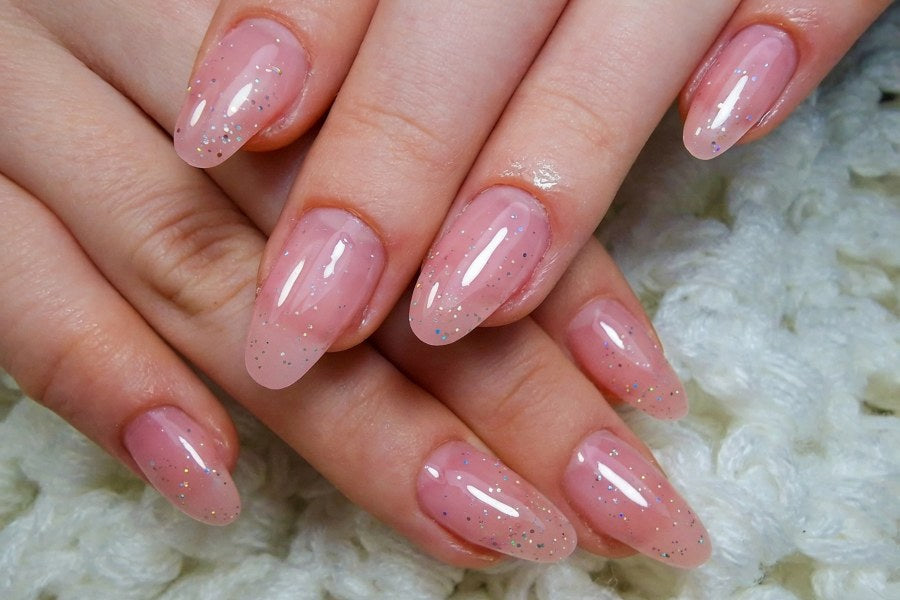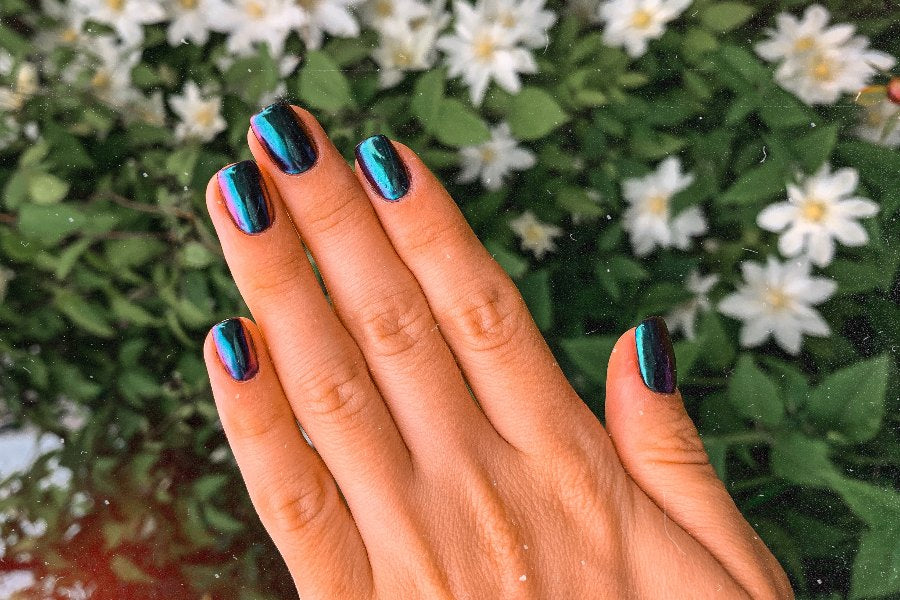What is Shellac Nails: A Complete Breakdown (2025)

What is Shellac For Nails?
Wondering exactly what is Shellac nails and why they've become so popular? Looking for a manicure that combines the best of traditional polish and gel durability? Shellac nails have revolutionised the nail industry since their introduction, and in 2025, they remain one of the most sought-after treatments in salons worldwide.
Shellac stands apart from other nail options due to its unique hybrid formula, combining the ease of application associated with traditional nail polish and the durability of gel. Unlike regular polish that chips within days or acrylic nails that can damage your natural nails, Shellac offers the perfect middle ground: a glossy finish that lasts without compromising nail health.
Whether you're a salon owner, nail tech, or simply someone looking to understand the difference between Shellac and other manicure options, this guide covers everything you need to know for 2025.
What Are Shellac Nails?
The Science Behind the Shellac

Shellac is not simply another type of nail polish - it's a patented product developed by Creative Nail Design (CND) that has transformed the manicure experience. What makes Shellac truly unique is its hybrid formulation that combines elements of traditional nail polish with gel technology. This innovative formula contains monomers and radical initiators that work together to create a durable finish.
The science is quite fascinating: when the Shellac polish is applied to nails and exposed to UV light, the tiny molecules (monomers) and larger molecules (polymers) in the formula bind together through a polymerisation process. This chemical reaction transforms the liquid polish into a solid, durable coating that adheres firmly to the nail's surface without damaging it. The result is a thin, lightweight layer that provides exceptional shine and long-lasting wear.
Unlike other gel polishes composed solely of acrylic monomers and oligomers, Shellac contains more lacquer in its formula. This higher lacquer content is what allows Shellac to provide a hard, high-gloss finish that resists chips and nicks while ensuring zero damage to natural nails when properly applied and removed.
Difference Between Shellac and Regular Nail Polish: Key Comparisons
Traditional nail polish relies on air drying through evaporation, which often results in a relatively soft coating vulnerable to chipping. Most regular polish begins showing wear within 3-7 days, requiring frequent touch-ups or complete reapplication. The drying process alone can take five to fifteen minutes between coats, making a traditional manicure both time-consuming and prone to smudging.
Shellac polish, by contrast, offers significant advantages. After application and curing under a UV lamp, Shellac nails last 10-14 days without chipping or dulling - more than twice the lifespan of regular polish. Unlike traditional liquid gel formulations, Shellac creates a flexible coating that moves with your real nail, preventing the cracking that leads to premature wear. There's zero dry time once the final cure is complete, meaning you can immediately reach into your handbag or pocket without fear of smudging your fresh manicure.
The finish of Shellac is notably harder and glossier than traditional polish, maintaining its shine until it's time to remove Shellac nails. To get your Shellac nails removed, you can visit professional salons that use a gentle soaking method without damaging the underlying nail bed. Alternatively, you can remove Shellac at home with these easy steps.
For busy professionals who don't have time for weekly manicure maintenance, Shellac provides a practical solution that stays perfect through everyday activities and quickly deteriorates regular polish. However, traditional polish might be more suitable for those who enjoy frequently changing their nail colour or prefer to avoid UV light exposure.
Elevate Your Shellac Game with Premium CND Supplies
Explore our range of authentic CND gel polish supplies, including base coats, colour options, and top coats designed specifically for optimal Shellac performance. Shop now!
The Shellac Application Process
The Complete Gel Manicure Guide: Shellac Application Step-by-Step

The Shellac manicure process follows a specific protocol that ensures optimal results and longevity. Here's a comprehensive breakdown of what happens during a professional Shellac application:
- Nail preparation: The process begins with a thorough cleaning of the nails to remove any oils or residue. The nail technician will gently push back cuticles, shape the nails to your preference, and lightly buff the nail's surface to create the perfect canvas for adhesion.
- Base coat application: A thin layer of Shellac base coat is applied to each nail, taking care to seal the free edge. This layer is then cured under a UV light for 10 seconds or an LED lamp for 5 seconds.
- Colour application: Two thin coats of your chosen Shellac colour are applied, with each coat being cured under the lamp between applications. This precision ensures even coverage and prevents pooling or uneven texture.
- Top coat finish: A final layer of Shellac top coat is applied and cured, sealing in the colour and providing that signature high-gloss finish.
- Cleansing: After the final cure, a cleansing wipe removes any residual sticky layer, leaving nails completely dry and ready to go.
The entire Shellac manicure process typically takes 30-45 minutes, which is significantly more efficient than traditional manicures that require extended drying time. This efficiency, combined with immediate dryness and longer wear, makes Shellac an increasingly popular choice in today's fast-paced world.
Essential Products for Shellac Manicures: From Base Coat to Top Coat

For a proper Shellac manicure, specific products are essential to achieve professional results:
-
CND Shellac Base & Top Coat: Using authentic CND products is crucial as they're formulated to work together as a system. Generic alternatives may not provide the same durability or could potentially damage natural nails.
-
Shellac colour polishes: CND offers a wide range of Shellac colours specifically designed for this system. These polishes contain the precise balance of ingredients necessary for proper curing and wear.
-
UV or LED lamp: A professional-grade lamp with the correct wavelength is essential for proper curing. UV lamps ensure the Shellac formula cures correctly, preventing issues like premature chipping or peeling.
-
Nail preparation products: Cleansers and dehydrators remove oils from the nail plate, ensuring optimal adhesion of the Shellac system.
-
Cuticle oils and aftercare: Cuticle oils and conditioners help maintain flexibility in the Shellac coating and hydrate the surrounding skin, extending the life of your manicure.
For nail technicians, investing in quality products from verified salons or suppliers ensures consistent results and satisfied clients. For those considering the at-home application, professional-grade products are equally important to achieve salon-quality results.
CND Shellac vs Other Nail Enhancements
Shellac vs Gel Polish: Understanding the Fundamental Differences

While Shellac and gel nails might appear similar to the untrained eye, there are significant differences worth understanding. The main difference lies in their formulation: gel polish is made exclusively of acrylic monomers and oligomers that bond when exposed to UV light, while Shellac combines both gel components and traditional polish elements.
Gel nails typically create a thicker, heavier finish on the nail compared to Shellac's thinner, more natural-looking appearance. This thickness difference affects both the feel and flexibility of the finished manicure. Many clients report that Shellac feels lighter and more like their natural nails than a gel mani does.
When it comes to durability, gel manicures generally last longer—often up to 3 weeks compared to Shellac's 10-14 days. However, this extended durability comes with a trade-off during the removal process. Gel polish requires more intensive filing and soaking to remove, which can potentially damage the natural nail if not done correctly. Shellac, with its unique formulation, breaks down more easily with acetone, making the removal process gentler and less time-consuming.
Another distinction is colour availability. Since gel polish isn't exclusive to one brand, there's a vast array of shades available from numerous manufacturers. In contrast, authentic Shellac is produced only by CND, limiting colour options somewhat, though their range continues to expand each year.
Shellac vs Acrylic Nails
Acrylic and Shellac represent two very different approaches to nail enhancement. Acrylic nails consist of a liquid monomer and powder polymer that, when combined, form a hard protective layer over the natural nail. This mixture hardens through air exposure rather than requiring UV light curing like Shellac.
The most significant difference lies in their purpose and application. Acrylic nails are designed to add length and strength, making them ideal for nail biters or those wanting dramatic extensions. They create a thick, durable nail coating that can be shaped into various lengths and styles. Shellac, conversely, is intended to enhance natural nails with colour and shine without adding significant thickness or length.
Durability also differs substantially between these options. Acrylic nails can last 6-8 weeks with proper maintenance and infills, whereas Shellac nails last 10-14 days before requiring removal and reapplication. This longevity difference reflects their different purposes: acrylic for long-term structural enhancement and Shellac for medium-term colour and protection.
The appearance and feel vary considerably as well. Shellac maintains a natural-looking finish that's flexible and thin, while acrylic creates a more rigid, thicker nail that's notably stronger but less natural in appearance. For clients concerned about maintaining natural nail health while still enjoying a polished look, Shellac often represents the gentler option.
Benefits of Shellac Nails
Why Choose Shellac?

Shellac nails offer numerous advantages that have contributed to their enduring popularity in the manicure world:
-
Long-lasting wear: Shellac polish resists chipping for 10-14 days, maintaining its glossy finish throughout. This extended wear period makes it economical and convenient for those who don't want to worry about frequent touch-ups.
-
Zero dry time: Once cured under the UV lamp, Shellac is completely dry and hardened, eliminating the frustrating wait time associated with traditional polish. You can immediately use your hands without fear of smudging or denting your fresh manicure.
-
High-gloss, professional finish: The shine achieved with Shellac remains intact until removal, providing a consistently polished appearance that traditional nail polish can't match.
-
Gentler on natural nails: Compared to other enhancement options, Shellac is formulated to be kinder to your natural nails. When applied and removed correctly, it causes minimal damage to the nail plate, allowing nails to remain healthy underneath.
-
Quicker, easier removal: Unlike gel or acrylic, Shellac can be soaked off in acetone in approximately 10 minutes without extensive filing or scraping of the nail's surface, preserving the integrity of your natural nails.
-
Perfect balance: Shellac strikes an ideal middle ground between the ease of traditional polish and the durability of harder enhancements, offering reasonable longevity without compromising nail health.
For those seeking reliable, beautiful nails without the maintenance commitment of more intensive enhancements, Shellac provides an ideal solution that looks professional while protecting natural nails.
Who Is Shellac Best For?
Shellac manicures are particularly well-suited for certain individuals and lifestyles:
-
Healthy natural nail enthusiasts: Those with relatively strong natural nails who want enhancement without damage will appreciate Shellac's gentle approach. Unlike more intensive treatments, Shellac works with your natural nails rather than completely covering or replacing them.
-
Busy professionals: If your schedule doesn't allow for weekly nail maintenance, Shellac's two-week wear period means less frequent salon visits while maintaining a consistently polished appearance.
-
Quick-dry seekers: For anyone who's ever smudged a freshly painted manicure, Shellac's immediate drying through UV curing eliminates this frustration entirely. No more sitting still for extended periods or waving your hands about to speed drying.
-
Chip resistance without bulk: Those who desire durability but dislike the thickness of acrylic or some gel systems will find Shellac's thin profile combined with chip resistance particularly appealing.
-
Nail health prioritisers: Clients concerned about long-term nail health often choose Shellac because, when properly applied and removed, it allows nails to grow and strengthen without the damage associated with harsher enhancement methods.
Specific scenarios where Shellac particularly shines include holidays (where it withstands swimming and sun exposure better than regular polish), special occasions (providing perfect nails throughout an event without worry), and everyday professional environments where a consistently groomed appearance is expected.
Shellac Nail Care & Maintenance
Nail Technician Tips: Extending Your Shellac Manicure Lifespan

To maximise the lifespan of your Shellac manicure and keep it looking fresh for the full 10-14 days, follow these professional maintenance tips:
-
Daily cuticle oil application: Applying cuticle oil not only hydrates the skin around your nails but also maintains flexibility in the Shellac coating. This flexibility prevents the rigid cracking that leads to chips and lifts. Apply the oil at least once daily, ideally before bed.
-
Protective gloves: When cleaning, washing dishes, or using household chemicals, wear gloves to shield your skin from harsh detergents and excessive water exposure. These elements can weaken the Shellac bond and cause premature lifting.
-
Proper nail use: Avoid using your nails as tools for tasks like opening cans, peeling labels, or scraping surfaces. Treating Shellac-enhanced nails as tools significantly increases the risk of chips and breaks.
-
Heat and chemical awareness: Minimise prolonged exposure to hot water, steam, and chemical agents (including hair products and perfumes), as these can compromise the integrity of the Shellac coating. Be particularly careful immediately after application, as the freshly cured Shellac is still stabilising.
-
Strategic touch-ups: If minor chips occur, a thin layer of clear top coat can temporarily seal the edge and prevent further lifting until your next salon visit. However, this should be considered a temporary fix rather than a permanent solution.
-
Regular maintenance: Rather than waiting until your Shellac manicure has significantly grown out or deteriorated, scheduling infills or maintenance every 10-14 days helps maintain a consistent appearance while protecting your natural nails.
With proper care, many clients report extending their Shellac manicures beyond the standard two weeks, though complete removal and reapplication are recommended after 14 days to maintain optimal nail health.
Proper Removal Process: What Every Nail Tech Should Know
The removal of Shellac nails is arguably as important as the application process for maintaining nail health. Professional removal at verified salons is always recommended, but if you need to remove Shellac at home, follow these steps carefully:
- Break the seal: Lightly buff the top layers of your Shellac manicure with a fine-grit buffer. This breaks the seal off the top coat and allows the acetone to penetrate more effectively.
- Prepare the acetone: Soak cotton pads or balls in 100% acetone (not regular nail polish remover, which won't be effective).
- Apply and wrap: Place the soaked cotton on each nail and secure it with aluminium foil, creating a snug wrap that keeps the acetone in contact with the Shellac.
- Wait patiently: Allow 10 minutes for the acetone to break down the Shellac polish. Rushing this step will lead to incomplete removal and potential damage.
- Gentle removal: After soaking, gently slide off the Shellac with a cuticle stick. It should come away easily without scraping or force. If resistance is met, rewrap and wait longer.
- Nail nourishment: Once removal is complete, wash hands thoroughly to remove all acetone residue, then apply cuticle oil and hand cream to rehydrate nails and surrounding skin.
NEVER peel or pick at Shellac nails, regardless of how tempting it might be when they begin to lift. Forcibly removing Shellac takes layers of your natural nail with it, potentially causing thinning, weakness, and even painful splitting that can take up to 6 months to fully repair. This damage can make future manicures more difficult and compromise overall nail health.
Professional Removal Starts with Quality Products
Our nail essentials and consumables category features products specifically formulated to maintain nail health during and after Shellac removal. Explore today!
Latest Shellac Trends for 2025
Colour Innovations

The Shellac colour palette continues to evolve in 2025, with several exciting trends dominating the Australian market:
-
Multi-dimensional finishes have revolutionised the Shellac landscape this year, with magnetic, holographic, and colour-shifting options gaining tremendous popularity. These innovative formulas create depth and visual interest that changes under different lighting conditions, offering a dynamic manicure experience previously only available with more complex nail art.
-
Minimalist negative space designs have become particularly trendy, incorporating the natural nail as an intentional element of the overall design. These sophisticated looks work exceptionally well with Shellac's precise application properties, allowing for clean lines and deliberate transparency that complements rather than completely covers the natural nail.
-
The beauty industry's broader shift toward sustainability is reflected in the development of eco-conscious Shellac options. New vegan-friendly formulations reduce environmental impact while maintaining the durability and shine that Shellac is known for. These products appeal particularly to environmentally conscious consumers who don't want to compromise on quality.
-
Custom-blended Shellac colours have emerged as a premium service in leading salons, allowing nail technicians to create bespoke shades tailored to individual clients. This personalisation trend reflects the growing desire for unique expression through nail aesthetics, moving beyond the limitations of pre-mixed colours.
Current colour trends for 2025 include muted, sophisticated neutrals with subtle shimmer, deeply saturated jewel tones, and unexpected colour combinations that reflect broader fashion trends. These innovative options have expanded Shellac's appeal beyond traditional manicure clients to include those who previously preferred more elaborate enhancement methods.
Design Techniques

Shellac nail art has evolved significantly, with several cutting-edge techniques defining the 2025 aesthetic:
-
Minimalist micro-detailing has become the hallmark of sophisticated Shellac designs, featuring tiny, precise elements that create visual interest without overwhelming the nail. These subtle details - thin lines, small dots, or delicate patterns—showcase the precision possible with Shellac's thin, controllable formula.
-
Nature-inspired textures are trending strongly in the Australian market, with designs mimicking natural materials like marble, tortoiseshell, and various stone effects. These organic patterns leverage Shellac's glossy finish to create realistic dimensional effects without adding physical texture to the nail.
-
Architectural negative space represents one of the most innovative approaches to Shellac nail art in 2025. These designs use geometric principles and deliberate absence of colour to create striking, modern manicures that feel both artistic and wearable. The precision possible with Shellac makes these technical designs achievable even on shorter natural nails.
-
Combination techniques that pair Shellac with minimal embellishments have gained popularity among those seeking something special without the bulk of traditional 3D nail art. Thin gold foil, delicate chrome powders, or subtle shimmer effects can be sealed within the Shellac layers for dimension without compromising wearability.
For busy professionals, low-maintenance designs that grow out gracefully have become particularly valued. These include gradient effects, strategic placement of colour that complements nail growth, and designs that intentionally incorporate the natural nail in a way that remains aesthetically pleasing as growth occurs.
New to Shellac? Start with the Perfect Kit
Our comprehensive nail polish collections & kits include everything nail technicians need to start offering professional Shellac services. From starter bundles to complete professional setups, we have options for every skill level and budget. Shop today!
Why Shellac Continues to Shine in 2025

As we've explored throughout this comprehensive breakdown, Shellac maintains its position as the perfect middle ground in the nail enhancement spectrum. It bridges the gap between traditional polish and more intensive treatments by offering remarkable durability without compromising nail health or natural appearance.
The unique technology behind Shellac truly provides the best of both worlds: the incredible shine and chip-resistance of gel systems combined with the thinness and gentler removal process associated with traditional polish. This balance makes Shellac as relevant and desirable in 2025 as it was when first introduced, perhaps even more so as consumers increasingly prioritise nail health alongside aesthetics.
Even as nail technology continues to evolve with new innovations entering the market regularly, Shellac remains at the forefront with its proven track record of quality, convenience, and relatively gentle approach to nail enhancement. The system's consistency and reliability have established it as a mainstay in the professional nail industry.



